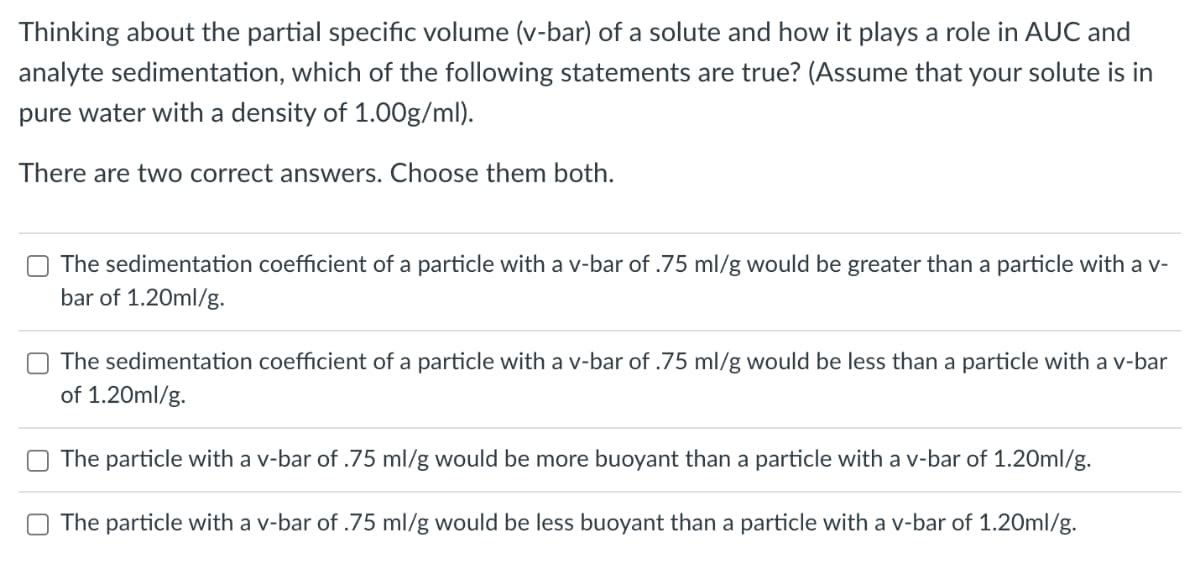Thinking about the partial specific volume (v-bar) of a solute and how it plays a role in AUC and analyte sedimentation, which of the following statements are true? (Assume that your solute is in pure water with a density of 1.00g/ml). There are two correct answers. Choose them both. The sedimentation coefficient of a particle with a v-bar of .75 ml/g would be greater than a particle with a v- bar of 1.20ml/g. The sedimentation coefficient of a particle with a v-bar of .75 ml/g would be less than a particle with a v-bar of 1.20ml/g. The particle with a v-bar of .75 ml/g would be more buoyant than a particle with a v-bar of 1.20ml/g. The particle with a v-bar of .75 ml/g would be less buoyant than a particle with a v-bar of 1.20ml/g.
Thinking about the partial specific volume (v-bar) of a solute and how it plays a role in AUC and analyte sedimentation, which of the following statements are true? (Assume that your solute is in pure water with a density of 1.00g/ml). There are two correct answers. Choose them both. The sedimentation coefficient of a particle with a v-bar of .75 ml/g would be greater than a particle with a v- bar of 1.20ml/g. The sedimentation coefficient of a particle with a v-bar of .75 ml/g would be less than a particle with a v-bar of 1.20ml/g. The particle with a v-bar of .75 ml/g would be more buoyant than a particle with a v-bar of 1.20ml/g. The particle with a v-bar of .75 ml/g would be less buoyant than a particle with a v-bar of 1.20ml/g.
Chemistry
10th Edition
ISBN:9781305957404
Author:Steven S. Zumdahl, Susan A. Zumdahl, Donald J. DeCoste
Publisher:Steven S. Zumdahl, Susan A. Zumdahl, Donald J. DeCoste
Chapter11: Properties Of Solutions
Section: Chapter Questions
Problem 40E: In lab you need to prepare at least 100 mL of each of the following solutions. Explain how you would...
Related questions
Question
Need solution urgently

Transcribed Image Text:Thinking about the partial specific volume (v-bar) of a solute and how it plays a role in AUC and
analyte sedimentation, which of the following statements are true? (Assume that your solute is in
pure water with a density of 1.00g/ml).
There are two correct answers. Choose them both.
The sedimentation coefficient of a particle with a v-bar of .75 ml/g would be greater than a particle with a v-
bar of 1.20ml/g.
The sedimentation coefficient of a particle with a v-bar of .75 ml/g would be less than a particle with a v-bar
of 1.20ml/g.
The particle with a v-bar of .75 ml/g would be more buoyant than a particle with a v-bar of 1.20ml/g.
The particle with a v-bar of .75 ml/g would be less buoyant than a particle with a v-bar of 1.20ml/g.
Expert Solution
This question has been solved!
Explore an expertly crafted, step-by-step solution for a thorough understanding of key concepts.
This is a popular solution!
Trending now
This is a popular solution!
Step by step
Solved in 4 steps with 3 images

Knowledge Booster
Learn more about
Need a deep-dive on the concept behind this application? Look no further. Learn more about this topic, chemistry and related others by exploring similar questions and additional content below.Recommended textbooks for you

Chemistry
Chemistry
ISBN:
9781305957404
Author:
Steven S. Zumdahl, Susan A. Zumdahl, Donald J. DeCoste
Publisher:
Cengage Learning

Chemistry: An Atoms First Approach
Chemistry
ISBN:
9781305079243
Author:
Steven S. Zumdahl, Susan A. Zumdahl
Publisher:
Cengage Learning


Chemistry
Chemistry
ISBN:
9781305957404
Author:
Steven S. Zumdahl, Susan A. Zumdahl, Donald J. DeCoste
Publisher:
Cengage Learning

Chemistry: An Atoms First Approach
Chemistry
ISBN:
9781305079243
Author:
Steven S. Zumdahl, Susan A. Zumdahl
Publisher:
Cengage Learning

